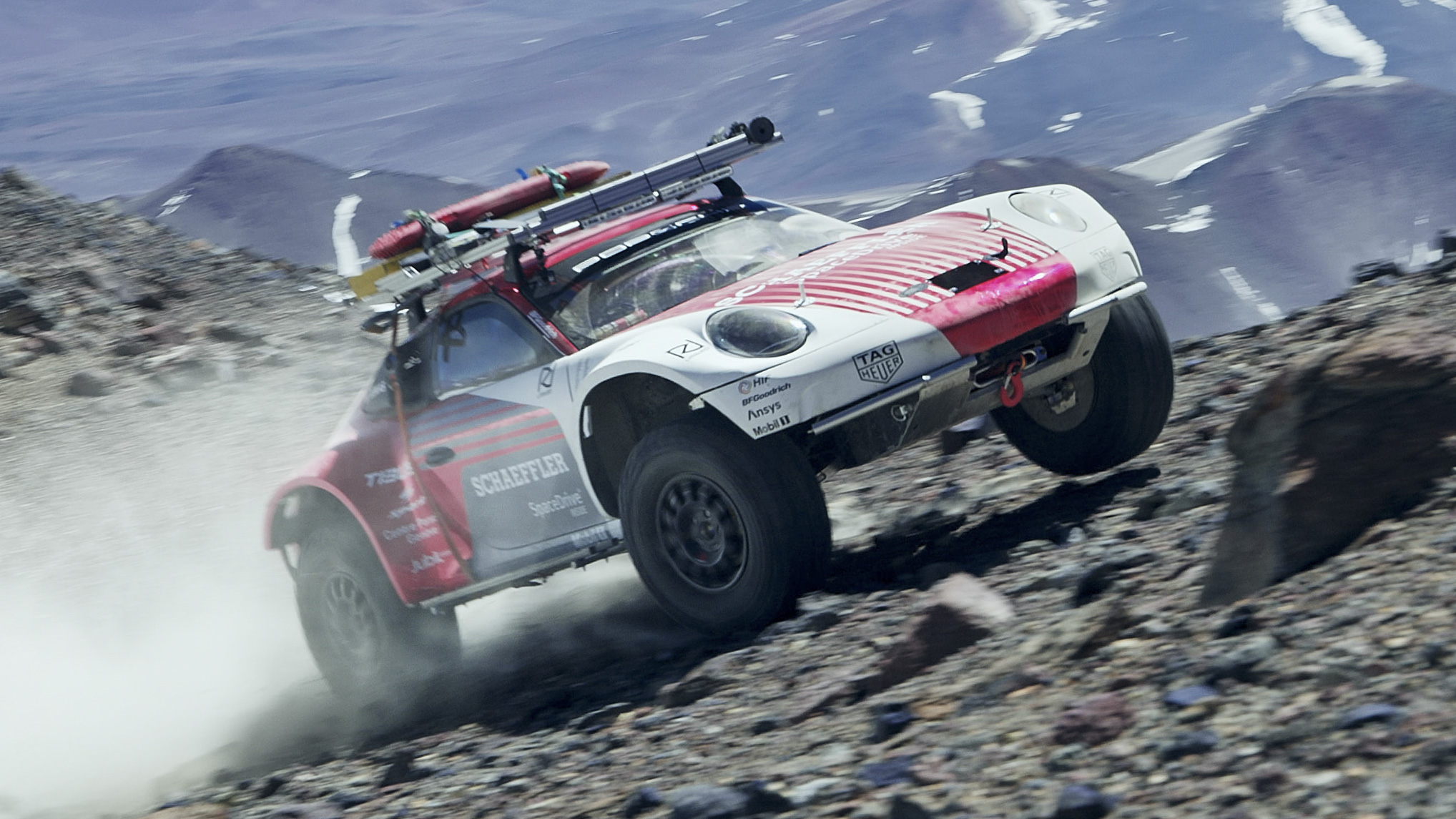

It’s so cool to see that there are still physical, flag-planting frontiers being conquered on planet Earth. Just this week, a team of mountaineers, engineers, and drivers got a heavily modded Porsche 911—even more extreme than the 911 Dakar—to the top of a volcano in Chile. They claimed a new world record for the highest elevation ever achieved with a car.
The record now stands at an incredible 22,093 feet/6,734 meters above sea level. That was hit on December 2, at the peak of the west ridge of the Ojos del Salado volcano in Chile, by Le Mans champion driver Romain Dumas in a Porsche 911 Carrera 4S named Edith.
Edith was the “lighter and more agile” of two specially built off-road 911s on the expedition, it and its counterpart (named Doris) were developed by Dumas’ team RD Limited in collaboration with Porsche.

Starting with current-gen all-wheel-drive seven-speed manual 911s, the expedition cars were equipped with portal axles like you’d have on a hardcore military vehicle.
Portal axles are super cool pieces of off-road tech that unlock a major ground-clearance bump. Basically instead of one stick going straight from the transmission to the drive wheel, having a portal axle means there’s a gear set at the hub of the wheel allowing the axle (spinning rod that moves the power) to be tucked up higher.
Here, I’ll whip up a little napkin diagram to illustrate what I mean:

Those portal axles bought the Porsche team 13.7 inches of ground clearance (a huge lift from the stock Carrera 4S’s 4.9 inches of clearance) and a gear ratio reduction that allowed for precise throttle input at low speed.
In addition to that, the cars ran underbody armoring made out of Aramid fiber. Aramid is aromatic polyamide, and used in things like firefighting gear and tactical body armor.
Inside, the cars had carbon fiber seats and some factory interior pieces were absent to keep the weight down.




The 443-horsepower 3.0-liter flat six was kept stock, running Mobil 1 lubricants and burning HIF eFuel—synthetic gasoline created in Chile, made from water and carbon dioxide. Porsche has invested in this tech in an effort to keep internal combustion cars viable into the future.
Even the 911s that are not named “Turbo” have turbochargers now, so the Carrera’s engine would not have been subjected to the brutal power-drain that a naturally aspirated engine would feel at that altitude (typically about 3% for every 1,000 feet above sea level). The Ojos del Salado spot Porsche drove is more than five miles into the air! Ambient temp was reported as “hovering around 20 degrees below freezing.” Whether that’s Celsius or Fahrenheit, that’s hardcore.

Compared to this trip’s peak of 22,093 feet, the top of the mighty Pikes Peak seems paltry at 14,115 feet above sea. Heck, Mount Kilimanjaro is 19,341. Everest is just over 29,000. The highest “roads” in the world are around 20,000 feet, and most of them are more like wide goat paths.
Porsche noted that its team “took two weeks to slowly acclimatize to the altitudes, slowly gaining in height day after day.” But also: “The cars had no such difficulties—the standard systems on the 911 sensed the thinner air and adjusted the fueling accordingly, meaning performance was maximized.”









Edith, Dumas’ lead car, also had a custom steer-by-wire system called Space Drive, developed and provided by Schaeffler Group. Porsche describes it as “…capable of meeting the unique and extreme demands of the volcano and the terrain, offering precision and detailed feedback to allow Romain Dumas to place the car precisely where he needed it…”
Steer-by-wire essentially means that instead of physical joints and rods connecting the steering wheel to the car’s front wheels, control is electronic. Theoretical advantages include greater customization in responsiveness and variable steering ratios that change with speed. This tech is new but might start appearing in production cars soon—the Lexus RZ450e, for example, will be one of the first production cars without an actual steering column.
Anyway, hopefully that’s enough context to let you fully appreciate this epic accomplishment of Edith, Doris, Romain Dumas, and the international team of adventurers. Chile, France, Germany, the United States, Canada and Switzerland were represented on the team, supported by Porsche, HIF Global, Schaeffler Group, Mobil 1, BFGoodrich and TAG Heuer. The actual record setting was logged Saturday, December 2, 2023 at 3:58 p.m. local time. I was sitting on my couch in a pile of chip crumbs; these guys were pulling up to a 22,093-foot peak in a pair of Porsches.
The only thing that makes this year’s automotive altitude record a little less cool is the fact that it looks a lot like a repeat of last year’s—Porsche hit 19,708 feet with Mr. Dumas and the same cars in 2022. In fact, we could even revisit last year’s video to get the vibe. But I still love to see humans striving to get higher, go further, and (literally) plant flags where no vehicle has gone before.

Porsche also owns the high-altitude electric car record, taking a Taycan Cross Turismo to about 15,889 feet above sea in 2022.
Got tips? Send ’em to tips@thedrive.com